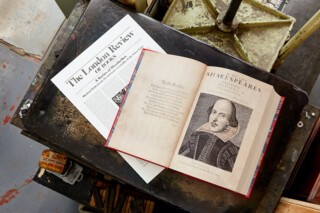The First Folio at 400
Sam Kinchin-Smith
The chance meetings, narrow escapes and spooky coincidences that fill Shakespeare’s romances are also a feature of the histories and provenances of the 235 surviving copies of the First Folio (and of other famous rare books: the codex containing the only copy of Beowulf, for example, with its brittle vellum and singed edges, that was thrown to safety from a window during the Ashburnham House fire of 1731).
One much told tale concerns the copy of the First Folio that was sent to the Bodleian in 1624, shortly after it was published, and later disappeared. In 1905, an undergraduate named G.M.R. Turbutt brought his battered family Folio to Oxford to be dated by the experts at the Bodleian; his great-great-great-grandfather had bought it c.1750. The librarians soon realised that what they held in their hands was the lost copy, the library’s own, still in its original bindings. A case of Jacobean theft was the initial assumption, but Michael Dobson explained what had actually happened in a piece in the LRB in 2001:
At the same price as its predecessors, the [1663-64] Third Folio offered even better value, and its superiority was immediately recognised by the Bodleian Library, which promptly sold off the copy of the First Folio … and invested in this edition instead. Given that they could only countenance having a single copy of this irreligious and unedifying volume on their shelves, this was an eminently sensible thing for Bodley’s librarians to do – though their successors came to rue it in 1905, when the Library’s former copy of F1 turned up in private hands and the Bodleian felt obliged to buy it back for around £3000.
(That’s perhaps £450,000 in today’s money; a snip, compared to the record set at a Christie’s auction in 2020: $9.98 million.)
To mark the quatercentenary of the registration of the First Folio at Stationers’ Hall on 8 November 1623, we thought we’d reprint the opening paragraphs of Dobson’s piece, replicating as closely as possible the processes that William and Isaac Jaggard relied on over the two years it took them to assemble Mr. William Shakespeares Comedies, Histories, & Tragedies (‘a series of headaches’, as Dobson puts it). A limited edition print is available now from the LRB Store; a short film about the project will follow in a few weeks’ time.
How’s this, though, for a coincidence? I’d been vaguely aware of a First Folio story in my family history, but for reasons I’ll have to take up with my analyst, the details never stuck. Yesterday, as I was talking with the originator of the Folio400 campaign, which has supported the LRB’s project, I mentioned this tenuous connection, and thought to myself: I must look that up later and find out which copy it was. A forehead slap: my maternal grandmother’s maiden name was Turbutt. The private hands that brought the Bodleian’s First Folio back to the library were her uncle’s (the owner was her grandfather).
It was saved for the nation from the relentless Henry Folger (who’d amassed 79 copies when he died) by an Edwardian crowdfunding campaign. G.M.R. Turbutt was killed in the first months of the First World War. The money, alas, is long gone.

Comments